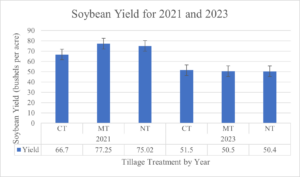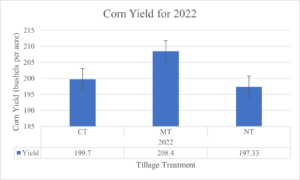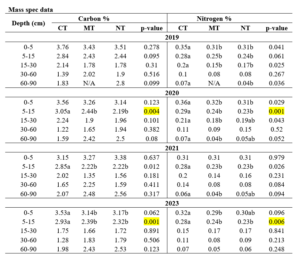Final report for GNC20-313
Project Information
In 2019, vast expanses of South Dakota were flooded. Many South Dakota producers are now left with the challenge of planting fields that were left fallow in 2019. Producers on the South Dakota Soil Health Coalition (SDSHC) Board state that they were able to access their no-till fields when neighboring conventional tillage fields were inaccessible. No-till management systems can protect our agricultural lands from flood, as well as drought, through increased soil organic matter and water holding capacity. Unfortunately, as severe weather events increase in frequency and decrease in predictability, many no-till acres risk being returned to tillage due to negative perceptions of increased management challenges and reduced yield.
Lake Area Technical Institute (LATI) in Watertown, South Dakota, operates a long-term, no-till demonstration farm north of their campus. The demonstration farm has been under no-till management for more than 20 years. Due to interest from area producers, strips of the farm have been returned to tillage in anticipation of yield gains. Initial plans by LATI for this experiment were to monitor yield only. Upon suggestion from South Dakota State University (SDSU) researchers and the SDSHC, baseline soil samples were collected prior to implementing the tillage treatments for comparison at the end of the three-year trial. However, there is high learning potential from collecting annual soil samples as is proposed here. For example, soil organic carbon changes may not be static from year to year and an opportunity exists to determine equilibrium rate constants using data from time zero, the baseline. The proposed SARE project would monitor changes in soil physical, chemical, and biological properties caused by tillage through aggregate stability, bulk density, soil chemical properties, and phospholipid fatty acid analysis (PLFA) annually for three years.
Learning outcomes include that area producers will witness the detrimental impacts of tillage on soil health parameters and insignificant increases in yield. Action outcomes include that area producers will use this information to determine if tillage is worth detrimental impacts on soil health parameters. Project summaries will be presented at two annual LATI producer field days, shared with SDSU Extension, the SDSHC, and with local Natural Resources Conservation Service (NRCS) offices. A publication will be submitted to a journal, such as Soil and Tillage Research, for peer-review.
03.27.2023: LATI has officially changed to Lake Area Techinical College (LATC)
Our hypothesis would include outcomes showing that, over the course of three years, there will not be significant yield increases in the tillage treatments compared to the no-till. However, significant improvements in soil physical, chemical, and biological properties in the no-till treatment compared to the tillage treatments will be observed. The primary learning outcome of this research will be utilization of quantitative data to inform producers on the negative effects of tillage on soil health properties. Coupling quantitative soil property data with yield and economic data, ample information will be available for area producers who are contemplating which management system would be best for their operation. Learning outcomes from this project will lead to the primary action item of producers opting to maintain their existing no-till systems, or convert to no-till management systems.
Research
Lake Area Technical College (LATC), located near Watertown, SD, operates a long-term no-till demonstration farm that is under corn-soybean rotation. In 2019, two strips of tillage were implemented; one strip of "conventional tillage" (CT) and one of "minimum tillage" (MT). In total, there are three tillage treatments: CT, MT, and no-till (NT). The practices behind CT management include fall and spring tillage, while MT only consists of one pass.
Tillage strips were implemented in a N-S direction on a gently sloping (2-6% slope) hill with a Still Lake-Graceland silty clay loam soil type. Four replicates (blocks) per strip were sampled along a transect to encompass all landscape positions. Soil samples were collected from the 0-5, 5-15, 15-30, 30-60, and 60-90cm depths at the inception of the tillage trial for benchmark purposes, and after harvest in 2020 and in 2021. Due to a late harvest and early winter in 2022, the final project samples were taken in May of 2023. Samples from 2021 and 2023 were sent to Ward Laboratories in Kearney, NE for routine analysis. Samples from 2019-2021 and 2023 were analyzed for Total Carbon (%) and Total Nitrogen (%) via Isotope Ratio Mass Spectrometry (IRMS).
Microbial and aggregate stability samples were collected, but due to poor sample management by the graduate student (me), samples were either lost, compromised, or damaged to the point they could not be analyzed with confidence. Therefore, results will focus on % carbon and % nitrogen at depth for all sample dates and on %C from loss on ignition and nitrate (lb/a) for 2021 and 2023. Yield from 2021 to 2023 will also be mentioned.
RESULTS:
Results of the IRMS data for Total Carbon (%) and Total Nitrogen (%) are reported in Table 1. Data was analyzed via ANOVA and Fisher's LSD in R Studio. Using a p-value of p < 0.05, it was found that Total Carbon was greater in the CT treatment at the 5-15cm depth in 2020, 2021, and 2023, and was also greater in the 0-5cm depth in 2023. Data with missing values was not included in significant results. There was no difference between MT and NT treatments at these depths for Total Carbon. Total Nitrogen was greater in the CT treatment at the 0-5, 5-15, and 15-30cm depths in 2019. In 2020, Total Nitrogen was greater in the 0-5 and 5-15cm depths than both MT and NT, but at the 15-30cm or 60-90cm depth there was no difference between CT and NT. In 2021, Total Nitrogen was greater in the CT treatment at the 5-15cm depth, but there was no difference between CT and NT at the 60-90cm depth. In 2023, Total Nitrogen was greater in the CT treatment at the 5-15cm depth, but there was no difference between the CT and NT treatments at the 0-5cm depth. MT routinely had lower Total Nitrogen than CT and sometimes than NT.
Table 2 reports the data from Ward Labs for 2021 and 2023. In 2021, Organic Carbon was greater than both MT and NT at the 5-15cm and 60-90cm depths. In 2023, Organic Carbon was greater in the CT treatments than MT or NT at the 0-5 and 5-15cm depths. In 2021, Nitrate was greater in the CT than NT treatment at the 15-30 and 30-60cm depths. There was no difference in Nitrate between CT and MT, or MT and NT at any depth in 2021. In 2023, Nitrate was greater in the CT treatment than the NT treatment at all depths. Nitrate in the CT treatments was greater than MT at all depths except the 60-60cm depth in 2023. No significant difference in Nitrate between MT and NT was observed at any depth for 2023.
Soybeans were planted in both 2021 and 2023. There was no significant difference in bean yield between the tillage treatments in either year (Figure 1). Corn was planted in 2022, and MT had significantly higher yield than CT or NT (Figure 2).
DISCUSSION:
Although MT had greater corn yield than CT or NT in 2022, the additional carbon contributions from high yielding corn residue were not realized in the 2023 spring samples for MT. Carbon was routinely greater in the CT treatments than the MT or NT treatment. Greater levels of carbon at deeper depths in the CT treatment is likely due to the incorporation/mixing of crop residues deeper and more frequently than will happen in the MT or NT treatments. Liu et al. (2015) determined that there was greater microbial biomass carbon in plow tillage vs no-tillage at depths of 5-15cm and 15-30cm, meaning more microbes may be present at those depths to mineralize carbon. Additional release of carbon to the CT system could be from destruction of aggregates (Weidhuner et. al., 2021) making more carbon available for mineralization by microbes (Liu et al., 2015). This would be similar to having built up a healthy savings account, and then deciding to take a lavish vacation paid for by savings every year rather than putting money away. Mineralization of carbon from tillage can have immediate benefit, but would not be advantageous to long-term soil health. Although carbon was often greater at varying depths in the CT treatment, the increase in carbon did not result in increased yields. Additionally, greater nitrogen (Total N and Nitrate) in the CT treatment also did not contribute to greater yields. Therefore, the benefit of tillage was not truly realized in these plots. Results may have been different in a continuous-corn system, but in this corn-soybean rotation there was not a significant impact on yield.
An environmental concern identified by this research was the higher levels of Nitrate in spring samples from 2023 at all depths in the CT treatment. Samples were taken before planting in 2023. High levels of soil nitrate in the absence of a living root to utilize available soil-N is of environmental concern due to leaching potential. Hansen and Djurhuus (1997) observed that nitrate leaching was significantly reduced in no-till systems compared to spring- or fall-tillage systems. Others, however, have recorded that nitrate leaching may actually be greater in no-till systems due to improved porosity and soil structure. As nitrate leaches, it may enter either groundwater or find its way to downstream surface waters such as lakes and wetlands. Influxes of nitrate lead to eutrophication of local surface waters and can contribute to hypoxia in the Gulf of Mexico (NSTC, 2000). Our results support that reductions in tillage reduce nitrate leaching potential in the early growing season.
CONCLUSION:
Returning to conventional tillage from a no-till system did increase carbon in the CT treatments. However, the increase in carbon did not result in an increase in corn or soybean yield. This indicates that the CT treatment was mineralizing more previously-protected soil carbon, as well as seeing increases in soil carbon at depth due to mechanical incorporation of residues. Minimum tillage had the highest corn yield, although the carbon and nitrogen were lower than in the CT treatments. No-till was not significantly different from CT for corn or soybean yield, but less time, labor, equipment, and resources were required to maintain the NT treatment compared to the CT treatment. The additional risk of nitrogen loss from nitrate leaching in the CT treatment compared to MT or NT are of concern for surrounding ecosystem services. Based on these findings, converting the farm back to CT would not lead to increased grain yield and may lead to greater loss of investment in the form of leached nitrogen fertilizer while also creating environmental issues downstream.
FIGURES AND TABLES:

Figure 1: Soybean yield (bushels/acre) for 2021 and 2023 at the LATC demonstration farm near Watertown, SD.

Figure 2: Corn yield (bushels/acre) for 2022 at the LATC demonstration farm near Watertown, SD.
Table 1: Isotope Mass Spectroscopy (IRMS) results for Total Carbon and Total Nitrogen in all project years. Lower case letters indicate significant differences between treatments (CT, MT, or NT) at p < 0.05. If treatments have the same letter, they are not significantly different from each other.

Table 2: Organic Carbon (%) and Nitrate (lbs/a) data for 2021 and 2023. Lower case letters indicate significant differences between treatments (CT, MT, or NT) at p < 0.05. If treatments have the same letter, they are not significantly different from each other.

REFERNCES:
Hansen, E. M., & Djurhuus, J. (1997). Nitrate leaching as influenced by soil tillage and catch crop. Soil and Tillage Research, 41(3-4), 203-219.
Liu, M., Ussiri, D. A., & Lal, R. (2016). Soil organic carbon and nitrogen fractions under different land uses and tillage practices. Communications in Soil Science and Plant Analysis, 47(12), 1528-1541.
National Science & Technology Council (US) Committee on Environment. (2000). Integrated assessment of hypoxia in the northern Gulf of Mexico. National Science and Technology Council, Committee on Environment and Natural Resources.
Weidhuner, A., Hanauer, A., Krausz, R., Crittenden, S. J., Gage, K., & Sadeghpour, A. (2021). Tillage impacts on soil aggregation and aggregate-associated carbon and nitrogen after 49 years. Soil and Tillage Research, 208, 104878.
Educational & Outreach Activities
Participation Summary:
I attended the LATC Field Day in 2019 but was not in attendance in other years. Due to Covid-19, the annual nature of the field days were disrupted and afterwards the focus shifted from highlighting demonstrations on the farm to a plot tour for a seed company. Therefore, the previously anticipated field days were less accessible.
That being said, the data show interesting results that I would like to share with producers. I understand the project is ended, but I plan to reach out to Anthony Bly, SDSU Extension Soil Field Specialist, and offer to write an article to be published on SDSU's Extension website.
Project Outcomes
The conversion from no-till to conventional- or minimum-till took place in 2019. Crop yield from 2021-2023 only saw one year of positive impact from tillage and that was in the MT treatment. Conventional tillage required more time, labor, equipment, and resources to maintain than the NT or MT treatments did. Additionally, high levels of spring nitrate were observed in the CT treatment compared to NT or MT. Given these results, caution should be exercised if contemplating moving a well-established no-till system back to tillage. Returning to intensive tillage may see short-term increases in soil carbon, but our results show that increased carbon will not automatically result in higher yields. If early-season nitrogen leaches with spring rains, additional costs may be incurred for supplementing nitrogen later in the season in crops such as corn. At the end of the business day, agricultural producers are looking for profit, not solely yield. If a management practice, such as returning to conventional tillage, requires more inputs than a reduced- or no-till system, but does not significantly increase yield, profit suffers. Based on the results of this study, it would be recommended to maintain no-till production for conservation of time and inputs as well as yield and agronomic sustainability.
In conclusion, this project was of great use to me, personally, as a scientist. I learned the importance of sample management, processing, and follow-through, as well as the valuable lesson of taking on only what you can handle. There will always be valuable research to conduct, and good people who want quality results. However, a person shouldn't always say yes when they already have a plate that is at max capacity. In retrospect, I should have written this proposal with more realistic goals and metrics. I do feel this project still has value to the agricultural community, although results did not immediately show what we were anticipating to see (e.g. an increase in corn yield to the detriment of soil carbon from returning to conventional from no-tillage). Hopefully these benefits were articulated in the "Conclusion" portion of the Results and Discussion Section.
I would like to thank SARE and Beth Nelson for being patient and supportive as I struggled through this research. I very much appreciated the opportunity to work with Jeff York at LATC on this project, and he kept things moving. Thank you for this funding opportunity; I learned a lot about research and about myself. This project greatly helped solidify in my mind that I am stronger in teaching than in managing research projects, so thank you for helping hone my professional trajectory! I look forward to keeping up with SARE research as I continue on in my professional career. Thank you.